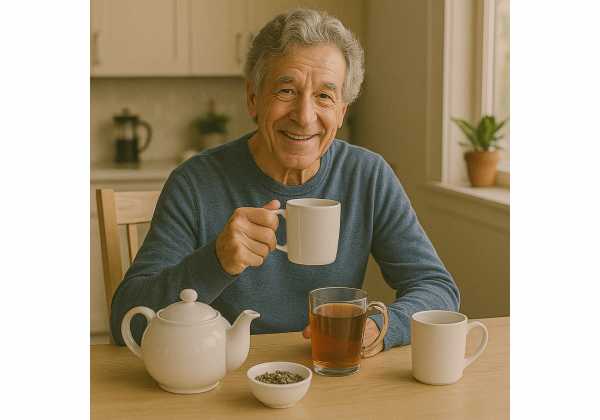
Coffee and tea travel with us through decades of workdays and weekends. Beyond comfort, both beverages bring bioactive compounds—caffeine, catechins, chlorogenic acids—that interact with metabolism, blood vessels, and the brain. The right amount and timing can sharpen focus, support cardiovascular health, and fit within a long-life pattern of eating. Too much, too late, or the wrong preparation can disturb sleep, raise reflux risk, or nudge lipids in the wrong direction. This guide translates the research into clear practices you can use tomorrow morning. We explain how different brews change what ends up in your cup, how to dose caffeine without taxing sleep, and where milk, sugar, and herbal options fit. For a broader blueprint that pairs beverage habits with diet quality, see our concise guide to longevity nutrition fundamentals.
Table of Contents
- Active Compounds in Coffee and Tea: Caffeine, Catechins, and Chlorogenic Acids
- Longevity Evidence: Cardiovascular, Metabolic, and Mortality Outcomes
- Caffeine Dosing and Timing: Cutoffs That Protect Sleep and Recovery
- Brew Methods and Preparation: Filtered, Espresso, Cold Brew, and Steep Times
- Add Ins and Sweeteners: Milk, Creamers, Sugar, and Iron Absorption
- Decaf, Half Caf, and Herbal Options for Sensitive Individuals
- Safety Notes and Interactions: Blood Pressure, Reflux, and Medications
Active Compounds in Coffee and Tea: Caffeine, Catechins, and Chlorogenic Acids
Coffee and tea are not just caffeinated water—they are complex infusions of hundreds of compounds that shape how you feel and how your body responds.
Caffeine, the stimulant with a schedule. Caffeine blocks adenosine receptors, reducing perceived fatigue and increasing alertness. Typical amounts per serving vary widely: a small espresso may deliver ~60–80 mg, a standard 240 mL cup of drip coffee 80–120 mg, and brewed black tea 40–70 mg (green tea often 20–50 mg). Sensitivity depends on genetics (CYP1A2 variants), habitual intake, body mass, and timing. In general, steady daily drinkers experience milder acute blood pressure rises and shorter-lived arousal from the same dose than occasional users.
Chlorogenic acids in coffee. These polyphenols modulate glucose handling by slowing carbohydrate absorption and influencing hepatic glucose output. They also contribute to flavor—perceived acidity and bitterness—and tend to be higher in lighter roasts and in some arabica varieties. Cold brew can taste smoother but still carries chlorogenic acids, though extraction differs with time and temperature.
Tea catechins and theaflavins. Green tea is rich in catechins, especially epigallocatechin-3-gallate (EGCG), while black tea contains oxidized polyphenols called theaflavins and thearubigins. Catechins support endothelial function (the flexibility of blood vessels) and may dampen post-meal oxidative stress. Black tea’s compounds contribute to lipid interactions and gut microbiome effects. Matcha, which suspends ground leaves rather than steeping and discarding them, typically delivers more catechins and caffeine per serving than brewed green tea.
Diterpenes in some coffee brews. Cafestol and kahweol are lipid-active molecules largely trapped by paper filters. Unfiltered methods—boiled coffee, French press, Moka pot, and some espresso styles—allow more diterpenes into the cup. Regular high intakes can raise LDL cholesterol in susceptible people. Paper-filtered drip coffee and many single-serve paper-pod machines deliver minimal diterpenes.
L-theanine in tea. This amino acid crosses the blood–brain barrier and can promote a calmer alertness when combined with caffeine, which is why some people experience tea’s stimulation as smoother. Theanine content varies by tea type, plant cultivar, shading practices (e.g., gyokuro, matcha), and steep time.
Acids, tannins, and your stomach. Coffee’s organic acids and tea’s tannins (polyphenols that can bind proteins) affect taste and tolerance. Tannins can cause a dry mouthfeel and may provoke nausea if tea is taken on an empty stomach. Food buffers both drinks’ acidity and tannin effects.
Takeaway. Your best “longevity cup” is the one that matches your goals: higher polyphenols (green tea, lighter roast drip coffee), lower lipids (paper-filter coffee), or gentler stimulation (green or oolong tea). The next sections translate these properties into outcomes and daily practice.
Longevity Evidence: Cardiovascular, Metabolic, and Mortality Outcomes
Large cohort studies consistently find that regular coffee or tea drinkers often have lower risks of all-cause and cardiovascular mortality than non-drinkers. While observational data cannot prove cause and effect, several patterns appear across populations and analytic methods.
All-cause and cardiovascular mortality. Many cohorts show a U-shaped or J-shaped curve: the lowest risk often appears around 2–4 cups of coffee per day (or 1.5–3 cups of tea), with benefits flattening at higher intakes. For tea, pooled data indicate that moderate daily consumption is associated with modest reductions in all-cause and cardiovascular deaths. For coffee, regular intake—especially when filtered—tracks with lower mortality and fewer cardiovascular events in multiple analyses.
Metabolic outcomes. Coffee consumption is associated with lower risk of type 2 diabetes in dose–response fashion up to several cups per day, with similar or slightly smaller associations for decaf, suggesting that chlorogenic acids and other non-caffeine compounds contribute. Tea, particularly green tea, has been linked with improved markers of endothelial function and small reductions in fasting glucose or waist circumference in select trials.
Blood pressure nuance. Caffeine acutely raises blood pressure, most noticeably in non-habitual users. Habitual drinkers tend to develop partial tolerance, and large reviews generally do not find sustained hypertension risk from moderate coffee intake. Individual responses vary; some people see transient rises after a cup and should monitor at home, particularly if already hypertensive.
Lipids and brew method. Unfiltered coffee’s diterpenes can raise LDL cholesterol and total cholesterol in a dose-dependent manner. Filtered coffee does not show this effect. Espresso is complex: some studies note small increases in total cholesterol at higher daily intakes, while others suggest differences by machine, shot length, and serving size. If your LDL is a priority, paper-filtered drip is the safer baseline.
Cancer, liver disease, and neurodegeneration. Coffee intake is associated with lower risks of liver fibrosis, cirrhosis, and hepatocellular carcinoma, and it tracks with reduced risk of Parkinson’s disease in several cohorts. Tea’s associations with cancer risk vary by type (green vs black), region, and confounders.
Context matters. Lifestyle clustering can tilt results: people who brew at home may cook more, move more, or smoke less. Still, most analyses adjust for major confounders, and many report similar trends across subgroups.
What this means for your routine. A daily habit of 2–4 cups of coffee or ~2 cups of tea—timed earlier in the day, filtered if coffee affects your lipids, and balanced with sleep-friendly cutoffs—fits well within a longevity pattern. If you’re actively improving cholesterol numbers, pairing beverage choices with diet moves that target LDL (fiber, plant sterols, and cooking oils) strengthens results; see practical strategies for improving LDL and triglycerides.
Caffeine Dosing and Timing: Cutoffs That Protect Sleep and Recovery
Caffeine helps during focused work and training, but sleep pays the bill if intake runs late or high. The goals are simple: find your effective minimum dose, set a personal cutoff that protects sleep, and cycle lighter days.
Daily dose lane lines. For most healthy adults, staying at or below ~300–400 mg caffeine per day works well. That is roughly three 240 mL cups of brewed coffee or five to six cups of black tea. Smaller adults, people with anxiety or palpitations, and slow caffeine metabolizers (common with certain CYP1A2 variants) often do best around 100–200 mg per day. During heavy training or travel days, some people temporarily rise above these amounts; build in “lighter” days afterward.
What actually disturbs sleep? Evening caffeine reliably lengthens sleep latency and fragments sleep. Afternoon caffeine also impairs sleep in many people, even when taken six hours before bed. Because half-life varies (about 5–7 hours on average, but longer in pregnancy and with some medications), a fixed “no later than X o’clock” rule works better than counting hours for most routines.
Set your cutoff. Choose a caffeine “sunset” 8 hours before your usual bedtime if you’re sensitive, 6 hours if you’re average, and 9–10 hours if you’re struggling with insomnia or early awakenings. Example: with a 10:30 p.m. bedtime, stop caffeine by 2:30–4:30 p.m. at the latest; many sleep-prioritizers pick noon.
Dose smarter, not bigger.
- Split doses: Two smaller 80–120 mg hits 3–4 hours apart often deliver steadier focus than one 250 mg bolt.
- Pair with food: Taking coffee or tea with breakfast or lunch blunts jitters and protects the stomach.
- Use a ramp: On especially demanding mornings, start with tea or half-caf, then step up only if needed.
Training timing. For performance, 1–3 mg/kg taken 45–60 minutes pre-workout helps many athletes. If you train after work, use the low end of that range—or choose tea—so you can still hit your sleep cutoff. Post-exercise caffeine late at night is more likely to disrupt sleep than to improve recovery, which is mostly driven by sleep quality anyway.
Taper tools. If you overshoot in the afternoon, switch to decaf or herbal options that preserve the ritual without the stimulation. Evening snack choices that support sleep—dairy or yogurt with fruit, or a small whole-grain bite—can counter bedtime hunger when you remove late coffee.
For nights when appetite lingers and you want sleep-friendly options with your decaf, skim our roundup of evening foods that support sleep.
Brew Methods and Preparation: Filtered, Espresso, Cold Brew, and Steep Times
How you brew reshapes what you drink—caffeine dose, polyphenols, acidity, and diterpenes all shift with method and time.
Paper-filter drip (including pour-over). Paper captures most cafestol and kahweol, the diterpenes that can raise LDL. If your cholesterol is a focus, this is the safest coffee default. Medium grind, 92–96°C water, and a 3–4 minute contact time usually yield 80–120 mg caffeine per 240 mL and robust chlorogenic acids. Lighter roasts preserve more chlorogenic acids and a brighter flavor; darker roasts mute acidity and bitterness but may reduce some polyphenols.
Espresso. Espresso concentrates flavor and caffeine into a small volume. A single shot (~30 mL) often holds ~60–80 mg caffeine. Paperless baskets and many metal filters allow more diterpenes than paper-filter methods, but the small serving size moderates total exposure for one or two shots. Frequent multiple espressos daily can nudge total cholesterol upward in susceptible individuals. If you love espresso and watch your lipids, limit daily shots, prefer paper-lined pods where possible, and emphasize filtered coffee on other days.
French press and boiled coffee. These brew styles provide rich body and higher diterpenes. If LDL creep is an issue, treat them as occasional rather than daily methods, or use paper-filter workarounds (some press systems accept paper disks).
Cold brew. Long, cool extraction yields a smooth cup with lower perceived acidity. Caffeine varies widely by recipe; concentrate can be very strong. Cold brew retains polyphenols, though the profile differs from hot extraction. If reflux bothers you, cold brew can be gentler—test it during the day rather than at night.
Tea variables you can control.
- Water temperature: Green tea prefers ~70–80°C; hotter water extracts more bitterness. Black tea and oolong perform at ~90–100°C.
- Steep time: 2–3 minutes for green tea keeps bitterness down while capturing catechins; 3–5 minutes for black tea balances flavor and polyphenols.
- Leaf form: Whole leaves and pyramid sachets allow better expansion than cramped bags, often improving taste and compound extraction. Matcha suspends the whole leaf, increasing catechin and caffeine delivery per cup.
Water and grind quality. Moderately mineralized water (not ultra-soft) and a burr grinder improve flavor consistency. If your tap water tastes flat or metallic, filtered water makes a noticeable difference.
Your “polyphenol plan.” If you want maximal plant compounds with minimal lipid impact, rotate paper-filter drip coffee with green or oolong tea. On days you aim to increase overall polyphenol intake from the rest of your diet, consider these polyphenol-rich choices to complement your cup.
Add Ins and Sweeteners: Milk, Creamers, Sugar, and Iron Absorption
What you add to the cup matters for calories, lipids, glucose response, and mineral absorption. The goal is to fit your taste and health targets without turning a healthy beverage into a dessert.
Milk and plant milks.
- Dairy milk: Adds protein and calcium; small amounts (30–90 mL) keep calories modest. Some studies suggest polyphenol–protein complexes may slightly change antioxidant activity in a test tube, but in real diets the effect is unlikely to be clinically important. If you like milk in tea or coffee, you can keep it.
- Plant milks: Check labels—many contain added sugars and oils. Unsweetened soy and pea milks provide protein; almond, rice, or oat milks are lower in protein. Fortified versions add calcium and vitamin D.
Cream and flavored creamers. Cream increases saturated fat quickly. Flavored creamers often add sugar and emulsifiers. If you prefer a richer cup, set a daily cap (e.g., 1–2 tablespoons) and balance with lighter choices elsewhere.
Sugar and syrups. A teaspoon of sugar (4 g) is 16 kcal. Two teaspoons twice daily across a year adds up. If you’re flattening glucose spikes or managing weight, consider stepping down by ½ teaspoon per week until you reach your minimum enjoyable sweetness. Alternatives like small amounts of stevia or erythritol reduce added sugars but can alter taste and digestion for some people. For a broader comparison of options, see our guide to smarter sweeteners.
Spices and cocoa. Cinnamon, cardamom, ginger, and unsweetened cocoa add flavor and polyphenols with negligible calories. Sprinkle lightly; large amounts of cassia cinnamon raise coumarin exposure.
Collagen and protein powders. Adding 10–20 g collagen or whey to coffee can boost protein at breakfast. Collagen does not provide all essential amino acids; if your goal is muscle maintenance, include complete proteins elsewhere.
Iron absorption and tannins. Tea polyphenols can reduce non-heme iron absorption when consumed with iron-rich plant foods. If you rely on beans, lentils, leafy greens, and fortified grains for iron, keep tea one to two hours away from those meals or add vitamin C–rich foods (citrus, peppers) to offset the effect. Coffee has a smaller, still notable, impact; spacing it from iron-heavy plant meals helps.
Dental enamel. Both beverages can stain. Rinsing with water afterward and avoiding sipping over many hours reduce staining and tooth exposure to acids.
Bottom line. Keep add-ins simple, measured, and consistent. Most people thrive with small amounts of milk or an unsweetened plant milk, minimal sugar, and mindful timing of tea around iron-rich plant-based meals.
Decaf, Half Caf, and Herbal Options for Sensitive Individuals
Not everyone tolerates caffeine well—and tolerance often changes with age, medications, and sleep patterns. You can keep the ritual and many benefits using decaf, blends, and herbal infusions.
Decaf basics. Decaf coffee still contains small amounts of caffeine (typically 2–5 mg per 240 mL). It preserves chlorogenic acids and flavor, though roast and decaffeination method matter. Water-process and supercritical CO₂ methods avoid solvent residues and often produce a cleaner taste. If caffeine worsens palpitations, reflux, or sleep, decaf allows you to retain the comfort and polyphenols without the stimulation.
Half-caf and tea-first strategies. Blending decaf with regular beans or alternating regular coffee with tea halves your load without losing enjoyment. Many people find that a regular morning cup followed by decaf or tea the rest of the day delivers focus without colliding with sleep. Green or oolong tea’s theanine can soften perceived stimulation for some drinkers.
Herbal infusions. Caffeine-free choices include rooibos, chamomile, peppermint, ginger, and hibiscus. Rooibos brings flavonoids with a gentle, nutty profile; chamomile helps many unwind; ginger supports digestion. Hibiscus is tart and rich in anthocyanins, but it may modestly lower blood pressure—helpful for some, not ideal if you are prone to low blood pressure or taking certain medications.
Reflux considerations. If reflux is your main concern, acidity and volume matter more than caffeine alone. Cold-brew decaf coffee, low-acid roasts, or rooibos/ginger infusions are common “gentler” options. Avoid large mugs late at night and test tolerance earlier in the day. For meal-level tactics that reduce symptoms, see our suggestions to reduce reflux triggers.
Pregnancy and breastfeeding. Many guidelines suggest keeping total caffeine to ≤200 mg/day in pregnancy. Decaf, half-caf, and herbal teas without stimulating herbs make it easier to stay below that threshold. Always verify herbs for pregnancy safety (e.g., avoid high-dose licorice root).
Anxiety, palpitations, and sleep. If you track higher resting heart rate, frequent night awakenings, or anxiety flares after caffeinated coffee, switch your second cup to decaf for two weeks and reassess. Many sensitive individuals do well with one morning cup plus decaf or tea thereafter.
Flavor and ritual still matter. Use the same brewing care you’d give to regular coffee or tea—fresh beans or leaves, appropriate water temperature, and measured steep times—to keep enjoyment high while you dial back stimulation.
Safety Notes and Interactions: Blood Pressure, Reflux, and Medications
Most adults can enjoy coffee and tea daily, but a few conditions and combinations call for specific adjustments.
Blood pressure and heart rhythm. Occasional drinkers may see a 5–10 mm Hg spike after a cup of coffee; habitual drinkers often see less. If your blood pressure is elevated, test your response with a home monitor: measure before and 30–60 minutes after a typical serving on two separate days. If readings jump, try smaller doses, switch a cup to tea or decaf, and keep caffeine earlier. Palpitations or atrial fibrillation history warrant a cautious approach—space caffeine earlier in the day, keep doses modest, and discuss thresholds with your clinician.
Lipids. If LDL cholesterol is your priority, prefer paper-filtered coffee most days and watch total espresso shots or French press sessions per week. Recheck lipids after 6–8 weeks of a filtered-first approach, particularly if you previously drank unfiltered methods daily.
Reflux and stomach comfort. Large volumes, high acidity, and late timing increase reflux symptoms. Choose smaller cups, finish beverages at least two to three hours before bed, and test cold brew or low-acid roasts. Tea tannins can cause nausea on an empty stomach; take with food if you’re sensitive.
Glucose and appetite. Taken alone, caffeine can blunt hunger temporarily but may increase later cravings in some people. When you drink coffee with a protein-rich breakfast, those swings are less likely. If you monitor glucose, compare similar breakfasts with and without coffee; some see modest differences, others none.
Medication interactions and cautions.
- Stimulants and decongestants: Additive effects can raise heart rate and blood pressure.
- Acid reflux and GI medications: Caffeine may counteract sedative effects at night; large late cups oppose reflux management.
- Antihypertensives: Acute caffeine can transiently oppose medication effects; spacing doses and keeping caffeine earlier can help.
- Thyroid hormone (levothyroxine): Coffee can impair absorption if taken together; separate by at least 60 minutes after taking the pill with water.
- Iron supplements: Tea and, to a lesser extent, coffee can reduce non-heme iron absorption. Take iron with vitamin C–containing foods and separate beverages by 1–2 hours.
- Anticoagulants and certain antibiotics: Some herbs (e.g., high-dose green tea extracts) are not equivalent to brewed tea; avoid concentrated supplements unless advised.
When to get personalized advice. Pregnancy, arrhythmias, uncontrolled hypertension, anxiety disorders, GERD, osteoporosis with low calcium intake, and significant insomnia are situations where tailored guidance improves outcomes. Bring your exact routine—brew method, serving sizes, and timing—to your next visit so your clinician can advise with precision.
Synthesis. Start with morning cups, filter your coffee if lipids are high, keep your caffeine cutoff early enough to protect sleep, and treat tea strategically around iron-rich plant meals. Adjust from there based on your own data—blood pressure readings, lipid panels, and sleep quality.
References
- Coffee Consumption and Risk of Hypertension in Adults: Systematic Review and Meta-Analysis (2023) (Systematic Review and Meta-analysis)
- Caffeine Effects on Sleep Taken 0, 3, or 6 Hours before Going to Bed (2013) (RCT)
- Association between espresso coffee and serum total cholesterol: the Tromsø Study 2015–2016 (2022)
- Tea consumption and risk of all-cause, cardiovascular disease, and cancer mortality: a meta-analysis of thirty-eight prospective cohort data sets (2024) (Systematic Review and Meta-analysis)
- Coffee and Cardiovascular Health: A Review of Literature (2024) (Review)
Disclaimer
This article provides general information and is not a substitute for personalized medical advice, diagnosis, or treatment. Coffee and tea can influence blood pressure, sleep, reflux, and medication absorption. If you are pregnant, have cardiovascular or gastrointestinal conditions, experience palpitations, or take prescription drugs, discuss your specific beverage habits—doses, timing, and brew methods—with your clinician or a registered dietitian.
If this guide helped you, please consider sharing it on Facebook, X (formerly Twitter), or any platform you prefer, and follow us for future updates. Your support helps us continue producing practical, evidence-based content.










